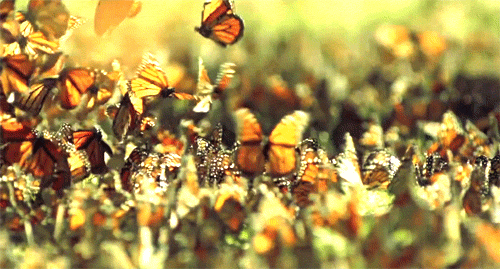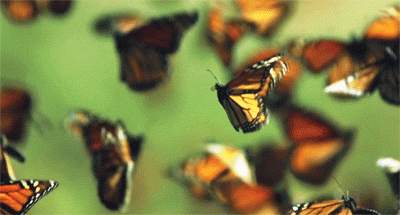In keeping with the spirit of Learn About Butterflies Day, celebrate by learning a little more about the wide range of butterflies. With over 20,000 types of butterflies worldwide today is the perfect day to learn about butterflies. Their wing spans can range from 1/2 inch to 11 inches. Did you know that in their adult stage butterflies can live from a week up to a year, depending on the species? Many butterflies migrate over long distances the most famous migrations are those of the Monarch butterfly from Mexico to the northern USA and southern Canada, a distance of about 2500 to 3000 miles. That’s a lot of air miles!
If you need some inspiration about how to celebrate, here are five ideas for you to try:
1. Start a butterfly garden.
One of the best ways to attract butterflies to your yard is to plant nectar-producing flowers that have red, yellow, orange, pink, or purple blossoms. Plant them in a sunny spot in a group so they grow in clusters.
2. Make a butterfly snack.
Fresh fruit is the perfect springtime snack, so use your imagination to whip up a fruity butterfly treat. You can also put a bit of fruit out in your garden for the butterflies to enjoy.
3. Learn something you didn’t know about butterflies.
Did you know that a butterfly can’t fly if its body temperature falls below 86°F? Or that they drink the tears of turtles? And they use their feet to taste?
4. Get crafty.
Grab some card, pipe cleaners and clothes peg and some pom-poms and here’s how you create your own butterfly:
- Decorate some card with markers and then spray it with water to create its wings.
- Once it dries, wrap a pipe cleaner around the middle of the card.
- Glue pom-poms onto the clothespin and clip the clothespin to the cards.
- Bend the pipe cleaner to make the antennae.
5. Visit your local zoo.
If in doubt learn from the experts. Heading to your local zoo and talking to the keepers that look after these amazing creatures from caterpillar to larvae and then to butterfly. They will be able to show you just how amazing these creatures are.

for PC ... March 13, 2017
Word of the Day
| |||
| Definition: | (noun) A trite or banal remark or statement, especially one expressed as if it were original or significant. | ||
| Synonyms: | banality, cliche, commonplace, bromide | ||
| Usage: | A trite platitude about his not caring to lose her was on his lips, but he refrained from uttering it. | ||

Idiom of the Day
idiot mittens— Mittens or gloves that are attached to one's sleeves by a length of yarn or string so as to prevent their being lost. |

History
Eli Whitney's Cotton Gin Awarded Patent (1794)
| By the end of the 18th century, the mechanization of fabric production in England had created a huge demand for US cotton, but cotton production was hampered by the large amount of manual labor required to remove the sticky seeds from the raw fiber. Whitney's cotton gin solved this problem, performing the work mechanically and quickly. |
Johann Strauss I (1804)
Tragically orphaned at the age of 12, Strauss was apprenticed to a bookbinder but studied violin on the side. After completing his apprenticeship, he performed in string quartets around Vienna before deciding to start his own band and write his own music. He enjoyed much professional success, but his family life was tempestuous. He forbade his children to study music, but they did anyway, with Johann II eventually overshadowing him.
Mamuralia
According to one Roman myth, Mamurius was a smith who was run out of the city because the shields he made for the soldiers failed to protect them when they were substituted for the sacred shield that had fallen from heaven. Another explanation is that Mamurius represented the old year, which had to be driven away on the day preceding the first full moon of the new Roman year. In any case, the rite that took place on March 14 involved leading a man wearing only animal skins through the streets of Rome. He was pursued and beaten with long white rods until he was driven out of the city.
Was Jane Austen Poisoned? New Evidence about the Writer's Weakened Eyes Raises Questions
On July 18, 1817, novelist Jane Austen died at the age of 41. Much of Austen's medical biography is murky, and how she died remains an enduring mystery. Historians, in the two centuries since, have dissected what little evidence exists.READ MORE:

Was Jane Austen poisoned? New evidence about the writer’s weakened eyes raises questions.
1681 - Composer Georg Philipp Telemann was born.
1743 - First American town meeting was held at Boston's Faneuil Hall.
1891 - The submarine Monarch laid telephone cable along the bottom of the English Channel to prepare for the first telephone links across the Channel.
1900 - In Holland, Botanist Hugo de Vries rediscovered Mendel's laws of heredity.
1914 - Henry Ford announced the new continuous motion method to assemble cars. The process decreased the time to make a car from 12½ hours to 93 minutes.
1923 - President Harding became the first U.S. President to file an income tax report.
1943 - U.S. President Franklin D. Roosevelt became the first U.S. President to fly in an airplane while in office.
1958 - Perry Como's "Catch A Falling Star" was certified as the first gold single.
1980 - Quincy Jones got a star on the Hollywood Walk Of Fame.

1995 - American astronaut Norman Thagard became the first American to enter space aboard a Russian rocket.
1995 - American astronaut Norman Thagard became the first American to enter space aboard a Russian rocket.


READERS INFO
Pi Day - March 14
It is a day to celebrate the mathematical constant pi (π).
Celebrated in countries that follow the month/day (m/dd) date format, because the digits in the date, March 14 or 3/14, are the first three digits of π (3.14), Pi Day was founded by Physicist Larry Shaw in 1988.
Celebrate Pi Day by having lots and lots of pie or eat foods that start with a pi, like pineapples and pizza or foods that are circular in shape like pancakes and cookie
Did You Know

...that pi is represented by the lower case Greek letter, π, because it is the first letter of the Greek work περίμετρος, meaning perimeter?


Albert Einstein (1879–1955) was a German-born theoretical physicist who developed the theory of relativity, one of the two pillars of modern physics (alongside quantum mechanics). Although relativity is his most widely remembered achievement, he published more than 300 scientific papers (along with over 150 non-scientific works), and the Nobel Prize in Physics he received in 1921 was "for his services to Theoretical Physics, and especially for his discovery of the law of the photoelectric effect"—a pivotal step in the evolution of quantum theory.
TAKE FLIGHT

Thousands of snow geese take flight during a snowy morning fly out at Bosque del Apache, New Mexico. It is loud and sounds like a passing train!

knit - ST. PATRICK'S DAY

knit, to 3 yrs
thanks, Rae

knit
thanks, Marcy

knit

knit


crochet - ST. PATRICK'S DAY
crochet
thanks, Lisa

crochet
crochet

crochet

RECIPE

CROCKPOT RECIPE
thanks, Jackie


SWEETS
thanks, Shelley

 \
\ADULT COLORING


CRAFTS
Wrapped Wreath
Wrap a Styrofoam wreath in brightly colored yarn. The “Love” emblem is made from pipe cleaners also wrapped in yarn.
CHILDREN'S CORNER ... puzzle

PUZZLE
Yellow House Jigsaw Puzzle
WORD SEARCH

| after bargain bless board cast claim close confidence critical | daily dead engrave exchange first foolish force | grasp hats learn moment never | outlet passage right silent single slab swing | tough trust usual within wonder worthy |
QUOTE


CLEVER

EYE OPENER


















A beautiful pictorial comment of beautiful PC. Cherish the memories and consider each one a hug. with love, GVS
ReplyDeleteI have recently started a blog, the info you provide on this site has helped me greatly. Thanksfor all of your time & work. learning braille
ReplyDelete